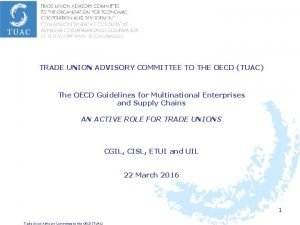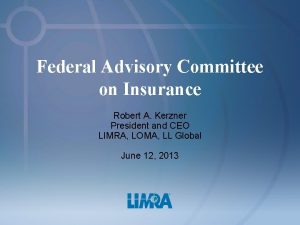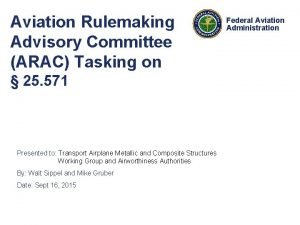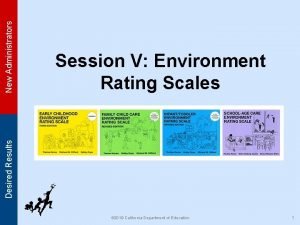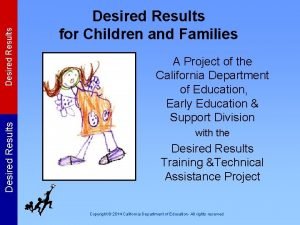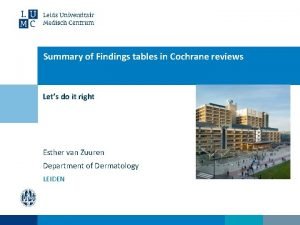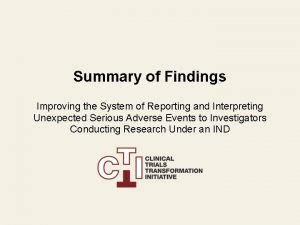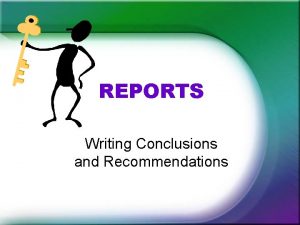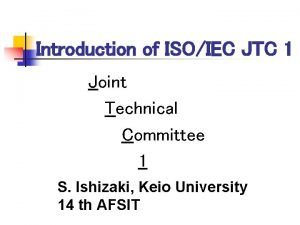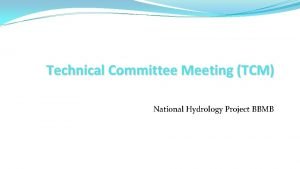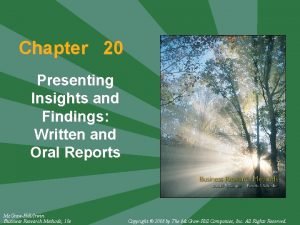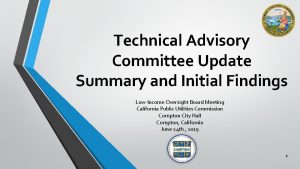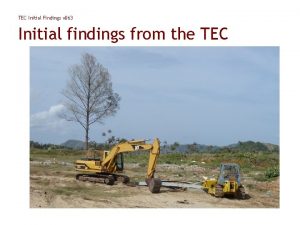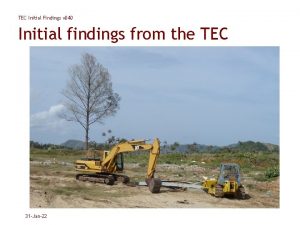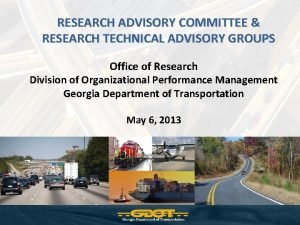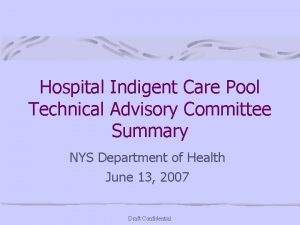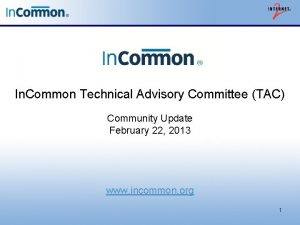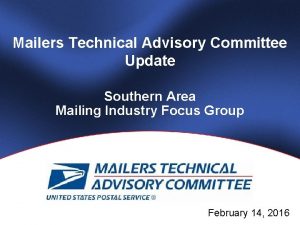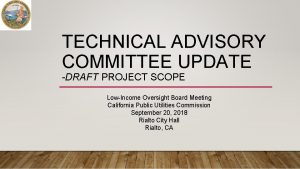Technical Advisory Committee Update Summary and Initial Findings














- Slides: 14

Technical Advisory Committee Update Summary and Initial Findings Low-Income Oversight Board Meeting California Public Utilities Commission Compton City Hall Compton, California June 24 th , 2019 1

Acknowledgements and Key Reminders • • This is an initial overview and we are continuing to explore relationships, refine results and validate findings through additional analysis and third party/stakeholder feedback Special thanks to PG&E, SCE, SDG&E, So. Cal Gas, CSD, CDSS, HUD, the Energy Division, Athens Research, and the Census Bureau for their contributions to date “Unduplicated public assistance household enrollment” refers to the enrollment of households where one or more adult is enrolled in one or more of the following: Cal. WORKS, Cal. Fresh, Tibal TANF or Medi-CAL Since the June 5 th TAC/LIEAP meeting, there have been two TAC meetings. The last was June 21. We will email a copy of this PPT to the board and post online at LIOB. Org. 2

Technical Advisory Committee Background • Study the potential benefits of leveraging government public assistance programs that already means test their enrollees as eligible for low-income rate payer programs such as CARE • Preliminary results from unduplicated household categorical data from Contra Costa County indicated a potential discrepancy between reported CARE eligibility and CARE eligibility when defined by unduplicated household data quantifying enrollment in three of these programs • Detailed analysis of unduplicated household categorical enrollment, CARE eligibility, CARE penetration rate and disconnections could enable improved and targeted outreach and highlight benefits of agency data sharing 3

Project Roadmap START Preliminary Analysis CARE Data AMI Snapshot 1 2 3 Data exploration & understanding Prepared CARE data as per the requirement Median Approach 5 Calculated the AMI categories, based on that calculated eligible 200 % FPL households, but more validation needed 4 Categorical Data Finalized median based Estimated households at and approach to Estimate below 200% FPL line using households below 200% different approaches FPL; needs more validation. Disconnection Data 6 7 Compared CARE & Census data with categorical data Analysis on energy burden & disconnection rate Overall insights Overall Insights 8 Overall insights 4

Data Collection The follow data sets were used for the analysis: • • • CARE enrollment by zip code • • • American Community Survey data from the Census Bureau CARE penetration rate by zip code CARE eligible households by zip code Utility disconnection data by zip code Single Metered Household Data by zip code (for Phase 2) Unduplicated household enrollment by zip code for Medi. Cal, Cal. Fresh, and Cal. WORKs by household Area Median Income data from Department of Housing and Urban Development (HUD) Other public assistance data (free lunch, etc. ) will be collected for Phase 2 5

CARE Enrollment and Public Assistance Enrollment Key Findings • In 1, 059 Zip codes (62%), public assistance household enrollment is higher than CARE enrolled households – often well above the current rate and the 100% CARE penetration rate • *This suggests the potential benefits of leveraging public assistance program for CARE outreach and enrolment. • Additional datasets from public assistance programs will be incorporated in phase 2. • ***Areas of highest population density may not be shown Unduplicated Categorical enrollment is higher than CARE enrollment Unduplicated Categorical enrollment is lower than CARE enrollment 6

CARE Enrollment and Public Assistance Enrollment Key Findings Unduplicated Categorical is lower than IOU Reported CARE Eligibility Unduplicated Categorical is greater than IOU Reported CARE Eligibility 7

CARE Eligibility and Public Assistance Enrollment Key Findings • Reported CARE 100% Eligibility is greater in 837 zip codes (red) • Unduplicated Household Categorical Enrollment is greater in 671 zip codes (blue). This is especially true in densely populated regions • Once we combine CDE (free and reduced lunch, etc. ) data we expect the blue zip codes to increase, as it will capture young and hard to reach families. Categorical Enrollment is greater Reported CARE Eligibility is greater 8

CARE Enrollment and Public Assistance Enrollment Key Findings Unduplicated Categorical is lower than IOU Reported CARE Eligibility Unduplicated Categorical is greater than IOU Reported CARE Eligibility 9

Initial Energy Burden Observations For Low Median Income Households (LMI) LMI Households: Households with less than 80% of Area Median Income Non-LMI Households: Households with More than 80% of Area Median Income Ø Many rural areas have a higher energy burden (10%) compare to suburban (5%) and urban areas (3%) 10

Initial Energy Burden Observations For Low Median Income Households (LMI) Ø Avg. Dollars Spend on Electricity (LMI Households) NOTE: LMI Households are households with less than 80% of Area Median Income, which is the income level used for comparison Left out Counties 80% Median income PLACEHOLDER CHART 11

Recommendations for LIOB Consideration • Request the IOUs review the findings from the comparison of unduplicated public assistance enrollment by household and CARE eligibility (Athens Research) and provide feedback – already some informal progress • Request the IOUs to identify any challenges to conducting CARE outreach in partnership with county agencies - including: • *This not meant to divert or distract from any ongoing work/activities • Examine the success of utilizing public assistance programs for outreach for programs similar to CARE in other states and/or utilities • 3 rd party review of the methodology and findings of the analysis (following steps above) • Others? 12

Next Steps • Gather all feedback from board members and other stakeholders • Combine existing unduplicated household dataset of public assistance programs with additional public assistance data from other agencies • Additional analysis and validation measures • Relationships to disconnections • Implement board recommendations through the committee process 13

Thank you 14
 Deferred update and immediate update
Deferred update and immediate update Nasa astrophysics advisory committee
Nasa astrophysics advisory committee Yashpal committee report on higher education
Yashpal committee report on higher education Trade union advisory committee
Trade union advisory committee Federal advisory committee on insurance
Federal advisory committee on insurance Aviation rulemaking advisory committee
Aviation rulemaking advisory committee Desiredresults.us
Desiredresults.us Drdp summary of findings
Drdp summary of findings Grade summary of findings table
Grade summary of findings table Summary of findings
Summary of findings Example of conclusion and recommendation in report
Example of conclusion and recommendation in report Joint technical committee 1
Joint technical committee 1 Technical committee on customs valuation
Technical committee on customs valuation Tcm technical committee meeting
Tcm technical committee meeting Semi-tabular presentation
Semi-tabular presentation



